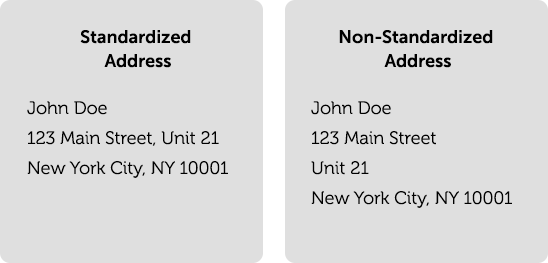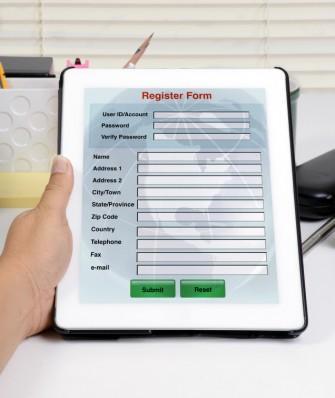You see address line 2 all the time. Your own web forms probably even have a field for it. However, did you know that address line 2 doesn’t really exist — at least in the U.S. Postal Service’s eyes? Not only does the USPS not require an address line 2, it doesn’t even acknowledge its existence.
USPS addressing standards
According to the USPS’s postal addressing standards, a complete address consists of just three lines:
Recipient Line
Delivery Address Line
Last Line
An example of a complete address using the three-line standard is:
John Doe
123 Main Street, Unit 21
New York City, NY 10001
Note that placing “Unit 21” on its own line, commonly referred to as “address line 2,” would result in a non-standardized address. While a human should be able to figure out that John Doe lives or works in unit 21, automated processing systems could have trouble.

Though address line 2 does not technically exist, the USPS does allow for additional information in a secondary address line (such as “deliver to dock 23.”) However, that information should be considered more like a comment area; it should not contain any deliverable address information. Our address validation software does scan address line 2 for this type of information, but there’s no guarantee the software will know what to do with it.
Suites and apartment numbers should be placed at the end of address line 1 while recipient details like name and company should go above the address.
What’s wrong with including an address line 2 field on your online forms?
Businesses commonly include an address line 2 field on their online forms, inviting end users to split address information as they see fit. When presented with two address lines, it’s only natural for users to separate floor, suite, and unit numbers into two separate lines. Some users will use address line 2 to add additional information such as “ATTN: John” or “Cross street: 2nd Avenue.”
 In short, too much information can be mixed up in address line 2, making parsing out important information difficult and inconsistent. For example, if the recipient’s name is mixed into address line 2 along with an apartment number or letter, it may not be entirely clear to the address validation system what the intention of the address is since the name should have been the first line (above the address) and the apartment number should be placed in the address line itself. Situations like this can often be fixed with address validation software, but the likelihood of getting a perfect address match is reduced since there are so many ways address line 2 can be filled in.
In short, too much information can be mixed up in address line 2, making parsing out important information difficult and inconsistent. For example, if the recipient’s name is mixed into address line 2 along with an apartment number or letter, it may not be entirely clear to the address validation system what the intention of the address is since the name should have been the first line (above the address) and the apartment number should be placed in the address line itself. Situations like this can often be fixed with address validation software, but the likelihood of getting a perfect address match is reduced since there are so many ways address line 2 can be filled in.
Another issue with presenting an address line 2 for end users to complete is it invites them to mistakenly enter an alternative address line 1 (for example, their home and work addresses if both are in the same city). If both address lines 1 and 2 contain complete, proper addresses, the address validation system cannot determine the originally intended destination.
As the saying goes, garbage in, garbage out. The closer to USPS standards you can get initially, the more likely it is for an address to be cleanly validated, and the more likely it is for your mail to arrive at its proper destination. Even though our software is constantly updated and improved to handle and fix improperly structured addresses, it’s always best to strive for clean input data when possible.
Should you eliminate address line 2 from your online forms?
If you want to invite garbage in, by all means keep asking for an address line 2. If you’d rather cut the confusion and get cleaner data from the start, stop using address line 2. USPS doesn’t require it — and doesn’t necessarily know what to do with it.
Some end users don’t know that they need to enter apartment or suite numbers to the main address line 1. You can help make address input more obvious to end users by adding an optional field to the web form labeled “unit number.” You could then append the unit number to address line 1. End result: less confusion, more consistent address validation, and better deliveries.













